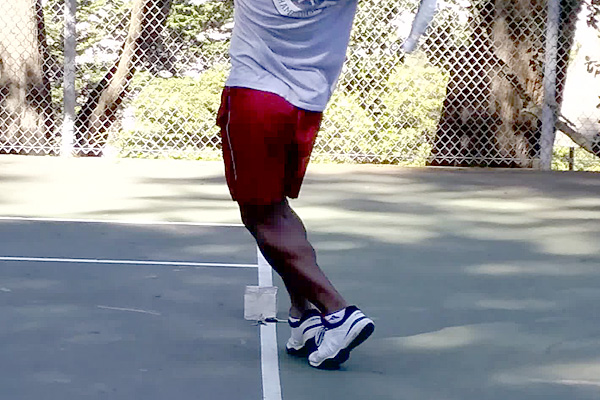Posts Tagged ‘foot faults’
 Ask Marla #11 – Breaking The Foot Fault Habit, Part 1 – Footwork
Ask Marla #11 – Breaking The Foot Fault Habit, Part 1 – Footwork

It’s been a while since my last “Ask Marla”, so I’m offering up a two-part piece on a matter of concern to all tennis players: foot faults. Many players foot fault, but most don’t know how to stop. So I asked Marla about foot faults, and some tips to help fix them.
Part 1 covers tips to correct foot faults, and Part 2 will cover other aspects of the serve that can contribute to foot faults, such as chasing your toss or inadequate knee bend.
Question: Do you have any tips to help players check if they foot-fault and fix it if they do?
Answer: The easiest thing a player can do is to back away from the baseline before hitting their serve. I don’t like doing that, however, because you give up valuable ground if you only have a marginal serve. The better alternative is to figure out which feet step over the line, and then work to stop them.
Try setting tennis balls in front of your feet when you serve: one in front of lead foot and one to side where back foot pulls up. Whichever ball moves (i.e. gets kicked or stepped on) will let you know the offending foot (or feet). Afterward, you can adjust your serve accordingly to better anchor your feet (for greater serve accuracy), and to better minimize potential foot faults.
Of course, the best option for checking foot faults is to have a friend take video or pictures of your serve along the baseline. This will clearly show which feet cross the line on your serve.
(SFTF Note: I’ve also struggled with foot faults. After watching a ton of matches with top-ranked players, I noticed that many barely move their feet when serving. So I’ve recently begun anchoring my front foot, the usual offender, to help clean up my service footwork. I also tried Marla’s tennis ball option to catch any movement across the line, but also used other items such as my keychain, a spare racquet, and a brick.
The brick actually proved to be the most helpful for me because of its’ size. There’s no way I could deny hitting it on the line if I crossed. The pictures at right shows a practice serve with the brick. The picture series below shows my cleaner footwork afterward. All pictures were taken by my phone on a tripod. The brick is a great tool, but pictures are indeed worth a thousand words! Whatever option you use on the baseline, try to supplement it with pictures or videos.
Chasing your toss across the line, or losing power because of knee bend now that your feet are anchored? Stay tuned for Part 2.
Got a tennis question? Send it via email or tweet for “Ask Marla”.
About Marla
Marla Reid is a respected tennis pro/coach in the San Francisco Bay Area. She’s coached nationally-ranked teams and players, and has over 15 years of experience at the NCAA Division I, II, and III levels. Marla owns and operates City Racquet Shop in San Francisco CA.
About City Racquet Shop
City Racquet Shop offers, superior products/services, outstanding customer service, and a community-oriented destination for tennis players to shop, hang out and talk about tennis.
City Racquet Shop online: www.cityracquetshop.com
City Racquet Shop on Yelp: http://www.yelp.com/biz/city-racquet-shop-san-francisco
City Racquet Shop on Facebook: https://www.facebook.com/cityracquetshop
 Calling Foot Faults in Social Doubles
Calling Foot Faults in Social Doubles
I play social doubles with a group of guys pretty much every Monday, Wednesday, and Friday in SF’s Mission District. And though I love playing with these guys, our sets sometimes provide perfect fodder for discussions of “Tennis Etiquette”! Today was one of those days.
While serving at 5-4 for the set, the receiver said, “Hey Kevin, you should watch your feet on the line.” Bugged by his intrusion, I responded, “Hey…everybody out here’s been on the line.”
The fact of getting called out for a foot fault doesn’t bother me. In fact, it’s something I’m well aware that I need to watch for whenever I step up to the line (because of my bad knees and wonky toss). What bothered me was that the guy who said that had stepped on the baseline at the start of every serve he hit in the set. I also felt like this was only an issue because he couldn’t get a racquet on my serve. I’m all for playing by the rules with respect to foot faults, but not selectively.
I stepped backed, then proceeded to hit my hardest serves “just because”, ending the set with an ace that sailed under my opponent’s racquet. Not quite vindication, but definitely a step to take the bad taste out of my mouth from his comment.
Was I wrong for being peeved at (selectively) being put on foot fault notice? Should foot faults even be called in a social doubles match that’s supposed to be fun? Let me know what you think by answering this two-question survey. Thanks.
Question 1




